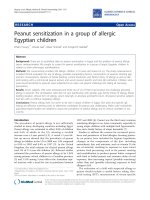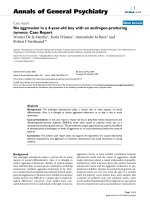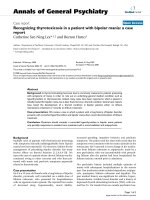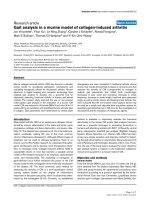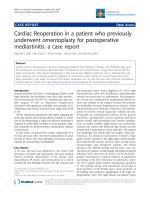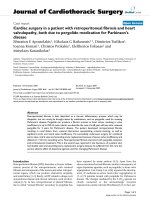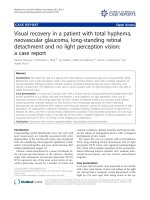Báo cáo y học: "Cardiac Reoperation in a patient who previously underwent omentoplasty for postoperative mediastinitis: a case rep" ppt
Bạn đang xem bản rút gọn của tài liệu. Xem và tải ngay bản đầy đủ của tài liệu tại đây (838.39 KB, 5 trang )
CAS E REP O R T Open Access
Cardiac Reoperation in a patient who previously
underwent omentoplasty for postoperative
mediastinitis: a case report
Mehmet S Bilal
1
, Onur Gürer
1*
, Ahmet Kırbaş
1
, Yahya Yıldız
2
and Ahmet Çelebi
3
Abstract
Sternal infection has become a rare but challenging problem with significant mortality and morbidity rates since
the introduction of sternotomy. Reported rates of mediastinal and sternal infection range from 0.4% to 5%. The
ideal reconstruction after sternal debridement is still controversial. Different methods, such as debridement and
open packing with continuous antibiotic irrigation, or sternectomy with omental or muscle transposition have
been proposed. In this study, we present the cardiac reoperation of a 52 year old man with corrected transposition
of great arteries (c-TGA) who had undergone a previous omentoplasty for postoperative mediastinitis.
Introduction
Sternal infection has been a challenging problem with
highmortalityandmorbidityratessincetheintroduc-
tion of sternotomy in 1957 [1]. Mediastinitis after car-
diac surgery is still an important complication
associated with significant morbidity and mortality [2,3].
Mediastinal and sternal infection rates range from 0.4%
to 5%.
As the subsequent septicemia and sepsis targeting the
heart, the sutures lines and prosthetic conduits or valves
can be life-threatening; a rapid and effective treatment is
required to avoid high mortality in these patients. Opti-
mal treatment for poststernotomy mediastinitis remains
controversial.
In this study, we present the cardiac reoperation of a
52 year old man with corrected transposition of great
arteries (c-TGA) who had undergone a previous omen-
toplasty for postoperative mediastinitis.
Case Report
A 52 year old man was admitted to our clinic with
shortness of breath and tachycardia. His past medical
history included replacement of the mitral valve
(biprosthesis 29 Sorin) and interposition o f a valved
conduit (25 mm Shelhigh) between the left ventricle and
the pulmonary artery with a diagnosis of c-TGA, right
atrioventricular valve (AV) insufficiency and pulmonary
stenosis two years prior to presentation. His postopera-
tive course was compli cated by mediastinitis (blood cul-
tures and exudate o f the surgical wound were positive
for methicillin-resistant Staphylococcus aureus), which
required long-term antibiotic treatment and debride-
ment of necrotic sternal fragments without success.
Eventually, an omentoplasty (release of the greater
omentum, sparing both vascular pedicles and short
gastric vessels, with tunneli ng to the anterior mediasti-
num via upper midline laparotomy) was performed,
sternum was closed with Robicsek type closure and the
wound with a subcutaneous tissue and skin. The patient
was discharged one month after the surgery. Upon pre-
sentation, his physical examination revealed a high
grade systolic murmur at the right upper sternal border,
decreased breath sounds and fine rales at lung bases,
hepatomegaly and peripheral oedema. His blood
pressure was 100/60 mmHg and his heart rate was
102 beats per minute. Cardiomegaly and bilateral pleural
effusions were observed on chest x-ray. Echocardio-
graphic examination revealed evidence of significant
narrowing at the left ventricular-to-pulmonary artery
(LV-PA) conduit (peak systolic instantaneous gradient
of 130 mmHg), along wit h significant narrowing (a
peak gradient of 29 mmHg and a mean gradient of
20 mmHg) and moderate regurgitation of the right AV
bioprosthetic valve. The right atrium was dilated. Upon
* Correspondence:
1
Department of Cardiovascular Surgery, Medicana Hospitals Camlica, Istanbul,
Turkey
Full list of author information is available at the end of the article
Bilal et al. Journal of Cardiothoracic Surgery 2011, 6:35
/>© 2011 Bilal et a l; licensee BioMed Central Ltd. This is an Open A ccess article distributed under the terms of the Creative Commons
Attribution License ( which permits unrestricted use, distribution, and reproduction in
any medium, provid ed the original work is properly cited.
reviewing these findings, reoperation, in order to replace
the prosthetic AV valve and the LV-PA conduit, was
planned.
A median sternotomy was performed. Omentum w as
prepared carefully and protected with warm compresses
(Figure 1). The right atrial pressure was 20 mmHg. Cardi-
opulmonary by-pass (CPB), utilizing femoral venous and
arterial cannulation, was perfo rmed. Mitral bioprosthesis
was replaced with a 29 mm St. Jude mechanical valve. On
inspection, it was evident that the narrowing was at site of
Figure 1 The view of the preparation of the omentum.
Bilal et al. Journal of Cardiothoracic Surgery 2011, 6:35
/>Page 2 of 5
the previous ventriculotomy. No evidence of degeneration
was observed at the valved conduit therefore the conduit
was excised prior to the valve. After enlarging the original
ventriculotomy, a 24 mm polytetrafluoroethylene (PTFE)
tube graft was interposed between the LV and proximal
conduit just below the valve. Normal sinus rhythm was
reestablished, and CPB was discontinued without the need
for inotropic support. Omentum was placed in the med-
iastinum and reattached (Figure 2). Sternum was closed
with conventional sternal c losure. Post-operative right
Figure 2 The placement of omentum into the mediastinum and its reattachment.
Bilal et al. Journal of Cardiothoracic Surgery 2011, 6:35
/>Page 3 of 5
atrial pressure was 10 mmHg. Wound healing was
uneventful and the patient was discharged on post-
operative Day 11. At the time of writing, he is at home,
with satisfactory activity for his age and no signs of
recurrent infection.
Discussion
Postoperative sternal osteomyelitis is a rare but serious
problem after cardiac surgery as the subsequent sepsis
targe ting the heart, suture lines, and prosthetic conduits
or valves can be life-threatening [1,4,5]. Recent advances
in cardiac surgery have enabled the surgical treatment
of an increasing number of elderly and immuno-
suppressed patients with multiple risk factors. However,
despite efforts to control hospital infections and delivery
of antibiotic treatment, the incidence of mediastinitis
has remained constant over the years. Ther efore, efforts
to avoid high morbidity and mortality in these patients,
has been required.
In 1963, antibiotic irrigation, debridement, and sternal
re-closure were introduced [4]. After that, in 1976, Lee
and colleagues [5] described complete excision of the
sternum with wide debridement of costal ca rtilages,
transposition of the omentum to the mediastinum with
primary closure, while Jurkiewicz and colleagues [6]
used muscle flaps. In 1995, Banic and colleagues [7]
reported the use of free latissimus dorsi flap in cases of
extensive sternectomy. In current practice, the most
commonly utilized muscles for sternal reconstruction
are the pectoralis major, rectus abdominus, latissimus
dorsi and greater omentum.
Pairolero and Arnold [8] reported that, they primarily
chose to obliterate the mediastinal space using omen-
tum when previous interventions with different muscles
have been unsuccessful. Ome ntal flaps have several
advantages. After complete or partial excision o f
sternum, the omental flap fills the mediastinal space and
obliterates the dead space. The flap contains large
number of immunologically active cells likely to be
responsible for its anti-infective properties. As the
omentum has extensive vascularization, and neovascu-
larization potential, the increased blood supply leads to
a higher concentration of antibiotics at the infection
site. By absorbing wound secretions, the omental flap
eliminates substrates for bacterial growth. Harvesting can
be performed rapidly without the need for specialist
knowledge, thus it can be undertaken by every surgeon [9].
The greatest disadvantage of utilizing the omentum in
postoperative sternal osteomyelitis treatment is the need
for a laparotomy. Laparotomy adds substantial surgical
trauma in patients who are already very sick. On the
contrary, the risk of potential peritoneal contamination
seems to be negligible. Laparotomy may lead to post-
operative pain that may interfere with the patient’ s
ventilatory dynamic and may cause mucus retention,
with possible resp iratory infections. Furthermore,
bec ause of the postoperative ileus, it is more difficult to
set the glucose values back to normal in diabetic
patients [10].
Although omentoplasty is effective in mediastinitis
treatment, it is a relative contraindication for future
cardiac interventions through median sternotomy. The
omental tissue has an excellent blood supply that limits
the spread of infection. However, it also has adhesive
properties that promote strong pericardial adherences
and new vascular anastomosis with adjacent vessels that
makeafuturesternotomyarealsurgicalchallengethat
no cardiac surgeon would like to face. Right or left thor-
acotomy may be a good alternative for these patients if
coronary artery bypass grafting or valve surgery is to be
performed, but not for other complex surgical proce-
dures in which median sternotomy is mandatory [11].
Conclusions
Omentoplasty for previous mediastinitis should not be
considered a major contraindication for cardiac reopera-
tions. Surgery is complex but technically possible. It is
our belief that omentoplasty provides extra security in
reoperations and safe to use in resternotomies.
Consent statement
Written informed consent was obtained from the patient
for publication of this case report and accompanying
images. A copy of the written consent is available for
review by the Editor-in-Chief of this journal.
Author details
1
Department of Cardiovascular Surgery, Medicana Hospitals Camlica, Istanbul,
Turkey.
2
Department of Anaesthesiology and Reanimation, Medicana
Hospitals Camlica, Istanbul, Turkey.
3
Department of Pediatric Cardiology, Dr.
Siyami Ersek Thoracic and Cardiovascular Surgery Center, Istanbul, Turkey.
Authors’ contributions
MSB drafted the manuscript. OG conceived the study and participated in its
design and coordination. AK collected data about the patient. YY
participated in the patient follow-up. AÇ participated in the study design
and coordination. All authors read and approved the final manuscript.
Competing interests
The authors declare that they have no competing interests.
Received: 22 December 2010 Accepted: 24 March 2011
Published: 24 March 2011
References
1. Bryant LR, Spencer FC, Trinkle JK: Treatment of median sternotomy
infection by mediastinal irrigation with an antibiotic solution. Ann Surg
1969, 169:914-20.
2. Blanchard A, Hurni M, Ruchat P, Stumpe F, Fischer A, Sadeghi H: Incidence
of deep and superficial sternal infection after open heart surgery. A ten
years retrospective study from 1981 to 1991. Eur J Cardiothorac Surg
1995, 9:153-7.
3. Loop FD, Lytle BW, Cosgrove DM, Mahfood S, McHenry MC, Goormastic M,
et al: J. Maxwell Chamberlain memorial paper. Sternal wound complications
Bilal et al. Journal of Cardiothoracic Surgery 2011, 6:35
/>Page 4 of 5
after isolated coronary artery bypass grafting: early and late mortality,
morbidity, and cost of care. Ann Thorac Surg 1990, 49:179-86, discussion 186-7.
4. Shumacker HB Jr, Mandelbaum I: Continuous antibiotic irrigation in the
treatment of infection. Arch Surg 1963, 86:384-7.
5. Lee AB Jr, Schimert G, Shaktin S, Seigel JH: Total excision of the sternum
and thoracic pedicle transposition of the greater omentum; useful
strategems in managing severe mediastinal infection following open
heart surgery. Surgery 1976, 80:433-6.
6. Jurkiewicz MJ, Bostwick J, Hester TR, Bishop JB, Craver J: Infected median
sternotomy wound. Successful treatment by muscle flaps. Ann Surg 1980,
191:738-44.
7. Banic A, Ris HB, Erni D, Striffeler H: Free latissimus dorsi flap for chest wall
repair after complete resection of infected sternum. Ann Thorac Surg
1995, 60:1028-32.
8. Yoshida K, Ohshima H, Murakami F, Tomida Y, Matsuura A, Hibi M, et al:
Omental transfer as a method of preventing residual persistent
subcutaneous infection after mediastinitis. Ann Thorac Surg 1997,
63:858-9, discussion 859-60.
9. Francel TJ, Kouchoukos NT: A rational approach to wound difficulties
after sternotomy: reconstruction and long-term results. Ann Thorac Surg
2001, 72:1419-29.
10. Jones G, Jurkiewicz MJ, Bostwick J, Wood R, Bried JT, Culbertson J, et al:
Management of the infected median sternotomy wound with muscle
flaps. The Emory 20-year experience. Ann Surg 1997, 225:766-76,
discussion 776-8.
11. Castedo E, Canas A, Varela A, Ugarte J: Does omentoplasty preclude
cardiac retransplantation? Chest 2001, 120:1425-6.
doi:10.1186/1749-8090-6-35
Cite this article as: Bilal et al.: Cardiac Reoperation in a patient who
previously underwent omentoplasty for postoperative mediastinitis: a
case report. Journal of Cardiothoracic Surgery 2011 6:35.
Submit your next manuscript to BioMed Central
and take full advantage of:
• Convenient online submission
• Thorough peer review
• No space constraints or color figure charges
• Immediate publication on acceptance
• Inclusion in PubMed, CAS, Scopus and Google Scholar
• Research which is freely available for redistribution
Submit your manuscript at
www.biomedcentral.com/submit
Bilal et al. Journal of Cardiothoracic Surgery 2011, 6:35
/>Page 5 of 5
